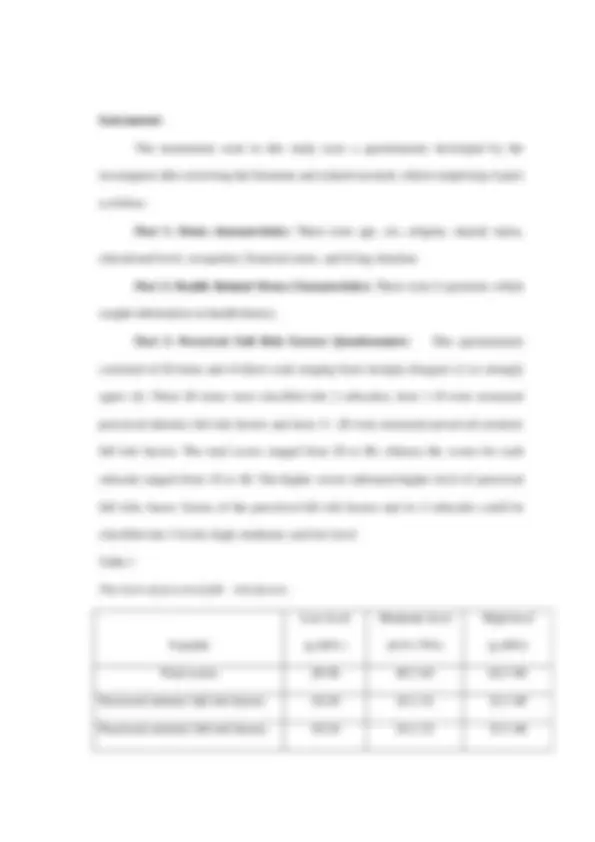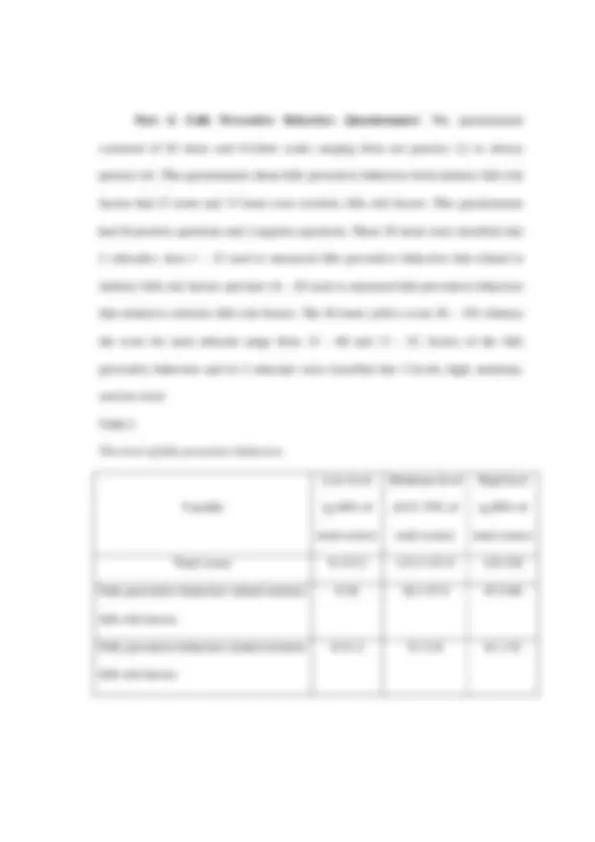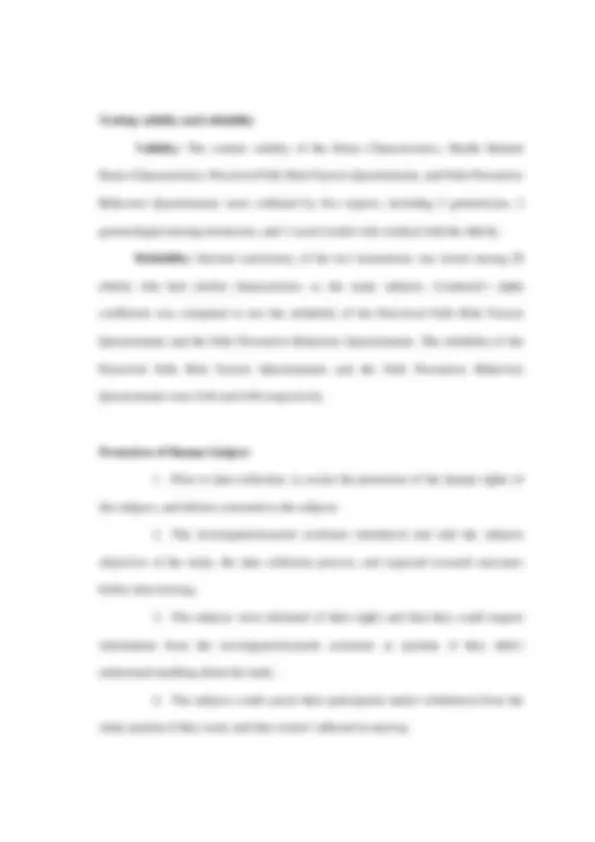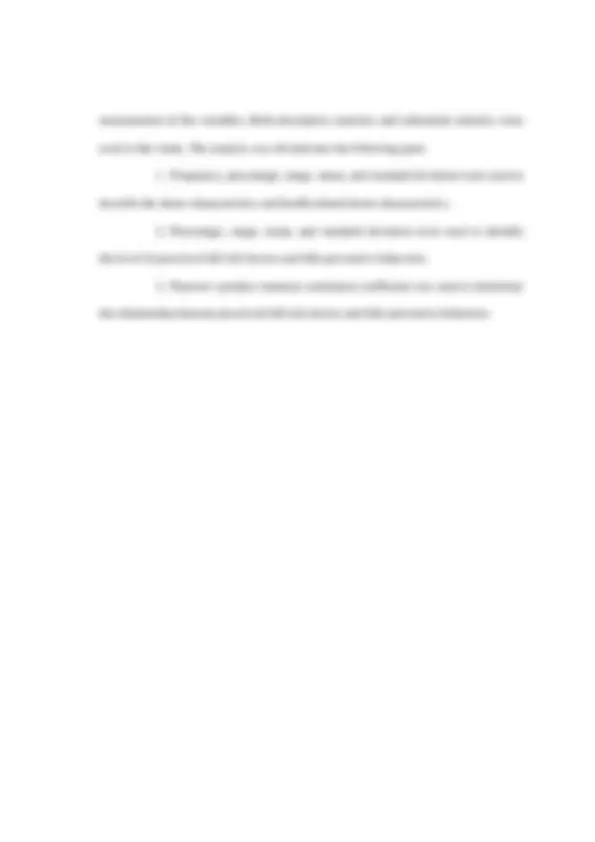






Study with the several resources on Docsity

Earn points by helping other students or get them with a premium plan


Prepare for your exams
Study with the several resources on Docsity

Earn points to download
Earn points by helping other students or get them with a premium plan
Community
Ask the community for help and clear up your study doubts
Discover the best universities in your country according to Docsity users
Free resources
Download our free guides on studying techniques, anxiety management strategies, and thesis advice from Docsity tutors
This descriptive correlational study was conducted to describe the perceived fall risk factors and falls preventive behaviors among elder living ...
Typology: Lecture notes
1 / 8

This page cannot be seen from the preview
Don't miss anything!





This descriptive correlational study was conducted to describe the perceived fall risk factors and falls preventive behaviors among elder living in community-dwelling and to examine the relationship between perceived fall risk factors and falls preventive behaviors among the elderly in community, Yala province.
Population and Subjects Population: The population of this study was the elderly people living in community, Yala province. Sample: This research used cluster sampling to recruit subjects from the elderly population who living in community, Yala province. Yala province was divided into two zones according to a high population density and geographical conditions (Yala Education Service Area Office 1, 2005). Zone one consisted of 3 districts (Muang, Kong-Pe nang and Raman) and Zone two consisted of 5 districts (Yaha, Kabang, Bannangsata, Tanto, and Batong). The elderly population in Yala province equal to 44,058 (Zone one: 28,676, Zone two: 15,382) (Yala Provincial Public Health Office, 2005). The sample size for this study was calculated by Yamane’s formula (Yamane, 1967). The figures in the formula are: n = N 1 + (N)(e) N = Elderly people in Yala Province n = estimate sample size
e = error estimation, this study used 0. n = 44058 = 396. 1 + (44058) (0.05)^2 The result of the sample calculation was 396 persons. The sample come up with 400 subjects and divided into 200 subjects per zone. After find the sample size, the investigator uses simple random sampling one district from 3 districts in zone one and one district from 5 districts in zone two; they were Muang and Bethong. Then simple random sampling one tumbon for each district, there were Lam pha ya and Ta noh mae roh. The 200 subjects from each tumbon were recruited by simple random sampling (Figure 2). The inclusion criteria for subjects consisted of the followings: age 60 years old or older both male and female, must be well oriented, and able to communicate
Simple random sampling one district for each zone
Simple random sampling one tumbon for each district
Figure 2 Steps for selecting sample in this study
Population (N) = the elderly population in community, Yala province = 44, Sample size (N)= 400
Bethong district
Zone one N = 28, n = 200
Ta noh mae roh Total Lam pha ya= 200(n) Total^ = 200 (n)
Muang district
Zone two N = 15, n = 200
Simple random sampling find subjects who fit in criteria from each tumbon
Part 4: Falls Preventive Behaviors Questionnaire: The questionnaire consisted of 28 items and 4-Likert scales ranging from not practice (1) to always practice (4). This questionnaire about falls preventive behaviors from intrinsic falls risk factors had 15 items and 13 items were extrinsic falls risk factors. This questionnaire had 26 positive questions and 2 negative questions. These 28 items were classified into 2 subscales; item 1 – 15 used to measured falls preventive behaviors that related to intrinsic falls risk factors and item 16 – 28 used to measured falls preventive behaviors that related to extrinsic falls risk factors. The 28 items yield a score 28 – 192 whereas the score for each subscale range from 15 – 60 and 13 – 52. Scores of the falls preventive behaviors and its 2 subscales were classified into 3 levels; high, moderate, and low level. Table 2 The level of falls preventive behaviors.
Variable
Low level (≤ 60% of total scores)
Moderate level (61%-79% of total scores)
High level (≥ 80% of total scores) Total scores 0-115.2 115.3-151.9 152- Falls preventive behaviors related intrinsic falls risk factors
Falls preventive behaviors related extrinsic falls risk factors
Testing validity and reliability Validity: The content validity of the Demo Characteristics, Health Related Demo Characteristics, Perceived Falls Risk Factors Questionnaire, and Falls Preventive Behaviors Questionnaire were validated by five experts, including 2 geriatricians, 2 gerontologial-nursing instructors, and 1 social worker who worked with the elderly. Reliability: Internal consistency of the two instruments was tested among 20 elderly who had similar characteristics as the study subjects. Cronbach’s alpha coefficient was computed to test the reliability of the Perceived Falls Risk Factors Questionnaire and the Falls Preventive Behaviors Questionnaire. The reliability of the Perceived Falls Risk Factors Questionnaire and the Falls Preventive Behaviors Questionnaire were 0.84 and 0.88 respectively.
Protection of Human Subject
questionnaires, demonstrate interview technique to them, and later observes their interviews. Any problems or unclear items were discussed.
Data analysis The Statistical Package for Social Science (SPSS) was used for data analysis. The procedures were carried out according to the objectives and the level of
measurement of the variables. Both descriptive statistics and inferential statistics were used in this study. The analysis was divided into the following parts.